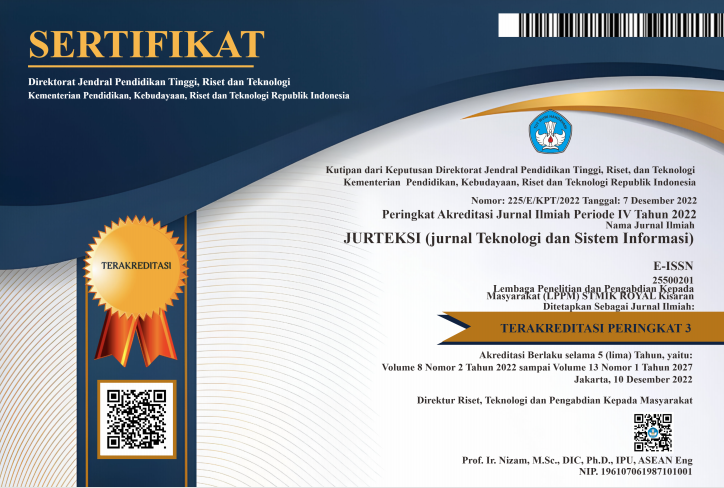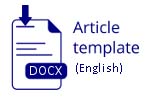WEBSITE INTERFACE EVALUATION USING GOAL-DIRECTED DESIGN METHOD IN XYZ UNIVERSITY
Abstract
Abstract: This research focuses on designing an interface refinement for the XYZ University company profile website that facilitates public information services. This research aims to increase the website's usability value by implementing the Goal-Directed Design (GDD) method in website interface refinement. GDD provides solutions that meet user needs and goals and address business goals. This research begins the interface design process by identifying user behavior patterns and goals to help deepen understanding of the domain, business goals, and technical constraints that will be used as a reference in website interface design refinement. Furthermore, usability testing is conducted using the System Usability Scale (SUS) as the measurement parameter. The usability aspects assessed in this research are effectiveness, efficiency, and satisfaction. Usability testing is conducted on the current website interface design and the website interface refinement design. Tests were conducted on six participants, consisting of three XYZ University students and three members of the general public. The findings show that the website's usability has increased from the previous value of 49.16 to 83.33. Based on the SUS score interpretation, the value that was previously categorized as "poor" increased to "excellent". Therefore, the result of the website interface refinement design using the GDD method has succeeded in increasing the usability value of the website.
Keywords: goal-directed design; system usability scale; university website; user interface
Abstrak: Penelitian ini berfokus pada perancangan perbaikan antarmuka website company profile Universitas XYZ yang memfasilitasi pelayanan informasi publik. Tujuan dari penelitian ini adalah untuk meningkatkan nilai usability website dengan mengimplementasikan metode Goal-Directed Design (GDD) dalam melakukan perancangan perbaikan website. GDD memberikan solusi yang memenuhi kebutuhan dan tujuan pengguna, dan juga menangani tujuan bisnis. Penelitian ini memulai perancangan antarmuka dengan mengidentifikasi pola perilaku dan tujuan pengguna untuk membantu memperdalam pemahaman tentang domain, tujuan bisnis, dan kendala teknis yang akan dijadikan acuan dalam perancangan antarmuka website. Selanjutnya, dilakukan usability testing dengan menggunakan System Usability Scale (SUS) sebagai parameter penilaiannya. Aspek usability yang diukur pada penelitian ini adalah efektivitas, efisiensi, dan kepuasan pengguna. Pengujian dilakukan terhadap kondisi awal website dan rancangan perbaikan antarmuka website. Pengujian dilakukan kepada enam partisipan yang terdiri dari tiga mahasiswa Universitas XYZ dan tiga masyarakat umum. Didapatkan bahwa nilai usability website mengalami peningkatan dari yang sebelumnya bernilai 49,16 menjadi 83,33. Berdasarkan skala penilaian SUS, nilai yang sebelumnya berkategori “poor†meningkat menjadi “excellentâ€. Dengan demikian, dapat disimpulkan bahwa hasil dari rancangan perbaikan antarmuka website dengan menggunakan metode GDD berhasil meningkatkan nilai usability website.
Kata kunci: goal-directed design; system usability scale; user interface; website universitas
References
N. M. Prastya, “Pemanfaatan Situs Web Resmi Lembaga Pendidikan sebagai Sumber Berita oleh Wartawan Surat Kabar Lokal di Yogyakarta,†J. Messenger, 2017.
W. Lestari and A. Susanto, “Analisis Performa Website ISI Surakarta dan Universitas Diponegoro Menggunakan Automated Software Testing GTmetrix,†Simkom, 2017.
H. Joo, “A study on understanding of UI and UX, and understanding of design according to user interface change,†Int. J. Appl. Eng. Res., 2017.
R. Guntupalli, “User interface design: methods and qualities of a good user interface design.,†Softw. Eng., 2008.
K. Sherwin, “University Websites: Top 10 Design Guidelines,†NNGroup, 2016.
J. Saptari, R. Iswandari, and R. Setyawati, “User Experience (UX) dalam pemanfaatan fasilitas Informal Learning Space (ILS) perpustakaan,†Berk. Ilmu Perpust. dan Inf., 2018.
2019 ISO 9241-210, “Ergonomics of Human-System Interaction — Part 210: Human-Centered Design for Interactive Systems,†2019.
A. Dix, “Human–Computer Interaction," Pear. Edu. Ltd., 2014.
J. Rubin and D. Chisnell, “Handbook of Usability Testing Second Edition,†Wiley Publishing, 1994.
A. Cooper, R. Reimann, and D. Cronin, “About Face 3: The Essentials of Interaction Design,†Wiley Publishing, 2007.
S. C. Peres, T. Pham, and R. Phillips, “Validation of the system usability scale (sus): Sus in the wild,†Proc. Hum. Factors Ergon. Soc., 2013.
U. Ependi, T. B. Kurniawan, and F. Panjaitan, “System Usability Scale Vs Heuristic Evaluation: a Review,†Simetris J. Tek. Mesin, Elektro dan Ilmu Komput., 2019.
A. Kantosalo and M. Nieminen, “Usability Evaluation with Children Case : Poetry Machine,†2014.
R. Caddick and S. Cable, “Communicating the User Experience: A Practical Guide for Creating Useful UX Documentation,†John Wiley & Sons Ltd, 2011.
R. H. and P. S. Pyla, “The UX Book: Process and Guidelines for Ensuring a Quality User Experience,†Elsevier Inc, 2012.
J. Sauro and J. R. Lewis, “Quantifying the User Experience Practical Statistics for User Research 2nd Edition,†Elsevier Inc, 2016.













